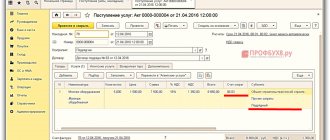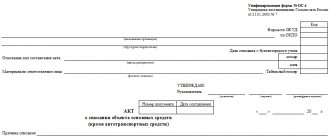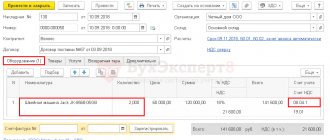5,00
5
| Reviews: | 0 | Views: | 4414 |
| Votes: | 1 | Updated: | n/a |
File type Text document
Document type: Act
?
Ask a question Remember: Contract-Yurist.Ru - there are a bunch of sample documents here
ACT ON LIQUIDATION OF FIXED ASSETS (APPLIED TO STANDARD FORM NO. OS-4) Appendix No. 1 to the Order of the State Bank of the USSR dated 06/07/89 No. 53 In relation to the standard form of the USSR State Statistics Committee No. OS-4 __________________________ I approve (enterprise, organization) __________________________________ (position and signature of the manager) “__” ___________ 20___ ACT No. ____ ON THE LIQUIDATION OF FIXED ASSETS FROM _____________ 20___ Commission consisting of: _____________________________________________________ (position, surname) _____________________________________________________________________ _____________________________________________________________________ _____________________________________________________________________, appointed by order (instruction) ________________________________ _____________________________________________________________________ dated ________________ 20___ No. _____________, on the basis of _________ _____________________ examined _____________________________________ (name of object), year of manufacture ______________, date of receipt __________________, score, cost __________, inventory No. ______________ and found it subject to liquidation (disassembly) on the following grounds: 1. Put into operation in ______________ 20___ (month) 2. Major repairs were made ________________. (quantity) 3. Technical condition and reasons for liquidation __________________ _____________________________________________________________________ 4. Quantity (weight) and assessment of items and materials obtained from disassembly that can be used, and unusable items at the price of scrap _________________________________________________________________ _____________________________________________________________________ _____________________________________________________________________ 5. Conclusion of the commission __________________________________________ _____________________________________________________________________ _____________________________________________________________________ Chairman of the commission _____________________ (signature) Members of the commission ______________________ _______________________ _______________________
Download the document “Act on liquidation of fixed assets (in relation to standard form No. os-4)”
What to write in the act of liquidation of an OS
The OS liquidation act is the main document that contains information for the further processing of the entire operation. It states:
- date of acceptance of the object for accounting;
- the year of its manufacture or construction;
- date of commissioning of the facility;
- useful life;
- original cost and amount of accrued depreciation;
- information about revaluations and repairs;
- the reason and justification for the partial liquidation of the facility;
- information about the liquidated parts of the facility;
- information about the possibility of further use of the OS;
- list and value of material assets that were obtained as a result of partial liquidation of the object;
- costs of partial liquidation of the facility.
The act is drawn up in two copies. The commission members sign it, and the director approves it. One copy is transferred to the accounting department, the second remains with the financially responsible person.
Types of acts of abolition
When writing off assets, organizations have the right to create a liquidation commission, which makes decisions after a thorough inspection of the object. In 2021, this requirement is not mandatory, however, many legal entities do not refuse the procedure, which allows for increased control over internal processes.
During the liquidation process, it is necessary to fill out various types of documentation
The disposal of fixed assets is accompanied by filling out the relevant documents, including:
- write-off order;
- act on liquidation of the facility;
- protocol on the commission's decision;
- invoice in standard form M-11, if after dismantling the object, materials suitable for further use remain.
Depending on the characteristics of the object, acts of abolition, which can be downloaded online, have several types of forms:
- OS-4 - standard form for writing off assets, except transport;
- OS-4a - form confirming the liquidation of cars;
- OS-4b - if it is necessary to record the disposal of a number of objects.
Actions of an accountant during partial liquidation
When carrying out partial liquidation of fixed assets in accounting, the accountant should remember the basic rules.
The useful life of an object after its partial liquidation is generally not revised.
After completing the partial liquidation work, you need to reduce the initial cost of the fixed assets by the cost of the liquidated part, and then recalculate the amount of depreciation if it was calculated using the straight-line method.
The remaining part of the object in tax and accounting must continue to be depreciated. Since the initial cost of the asset after its partial liquidation has decreased, the amount of monthly depreciation charges will also change.
The amount of new depreciation is calculated based on the remaining part of the object.
Under-accrued depreciation on the liquidated part of the fixed assets must be written off - both in tax and accounting.
Why is fixed assets liquidated?
The main reason for equipment disposal is the lack of further need for its use. This usually occurs taking into account the following circumstances:
- the fixed asset (OS) has failed and cannot be restored;
- the need to use equipment disappears due to changes in the type of activity of the enterprise;
- the need to liquidate equipment arises as a result of accidents, natural disasters or other unforeseen circumstances;
- obsolescence of assets;
- theft of property.
Depending on the value of worn-out equipment, it may be refurbished or sold. It is not always possible to carry out a major restoration of real estate, including unfinished construction, on a budget. Therefore, if the modernization of a fixed asset is unprofitable and implementation is difficult, management decides to liquidate it.
In some cases, the need for write-off applies only to individual components of the object. In such cases, the cost allocation method allows for partial dismantling of the equipment. This could be dismantling or destruction of only part of the OS. A good example is the closure of a certain part of a building, while other premises continue to be used for their intended purpose.
How to calculate the cost of the liquidated part of the OS
The procedure for determining the value of the liquidated part of an asset is not established by either tax or accounting legislation. You must establish it yourself and consolidate it in your accounting policies for tax and accounting purposes.
We can offer you several options.
1. Proportional to the area. You determine the share (specific gravity) of the liquidated part in the total area of the property based on information about the area of the property specified in the title or inventory documents. Then, based on the calculated share, you determine the initial cost of the remaining part of the OS.
2. In percentage terms. The liquidation commission has the right to independently determine the share of the liquidated part of the object, calculated as a percentage of the cost of the entire object. Thus, in the act of partial liquidation of a fixed asset object, it may be stated that 10% of the object is subject to liquidation. This way you calculate the cost of the remaining part.
3. Based on the cost of individual items that are part of a complex OS object. You take information about the initial cost of the liquidated part of the OS from the primary documents received from the supplier when purchasing the object. Based on it, you can calculate both the amount of accrued depreciation related to the part being liquidated and its residual value.
4.Independent assessment. If the value of the liquidated part of the property cannot be determined by any of the above methods, there is only one option left - to contact the services of an independent appraiser. In this case, the appraiser will have to determine not the market, but the initial value of the liquidated part or the share that falls on this part.
Features of drawing up an act
The form for the act of liquidation of fixed assets is not strictly regulated. Each enterprise has the right to develop its own document format indicating mandatory details, including the following:
- data about the write-off object, including registration, service life, initial and residual values, accrued depreciation;
- cost of expenses if dismantling is not carried out free of charge;
- information about possible repair work;
- reasons for write-off;
- signatures of the head of the organization and responsible persons, seal (if available).
If we are talking about the disposal of vehicles, then it is also necessary to have a certificate from the traffic police about deregistration of the car.
To avoid any questions in the future, it is important to take into account all the nuances when drawing up the act.
Related documents
- Certificate of acceptance and transfer of fixed assets. Form No. os-1
- Cash audit report (instruction of the Central Bank of the Russian Federation dated 10/04/93 No. 18 (as amended on 02/26/96)
- Act of markdown of goods
- Act-receipt for the performance of warranty and paid work on the repair of telephone sets. Form No. tf-2-22 (letter of the Ministry of Finance of the Russian Federation dated February 22, 1994 No. 16-36)
- Act-request for replacement (additional supply) of materials. Form No. m-10
- Analytical data on accounting for the costs of procuring and purchasing materials for journal order No. 6
- Analytical data on accounting for deviations in the cost of materials for journal order No. 6
- Certificate of assessment of the value of buildings and structures approved. Ministry of Agriculture of the Russian Federation on January 22, 1992 (appendix to the regulations on the commission for the privatization of land and reorganization of the collective farm (state farm)
- Certificate of assessment of the cost of machinery, equipment and transport (appendix to the regulations on the commission for the privatization of land and reorganization of the collective farm (state farm), approved by the Ministry of Agriculture of the Russian Federation on January 22, 1992)
- Certificate of assessment of the cost of unfinished capital construction (appendix to the regulations on the commission for the privatization of land and reorganization of the collective farm (state farm), approved by the Ministry of Agriculture of the Russian Federation on January 22, 1992)
- Act on the assessment of the value of working capital (appendix to the regulations on the commission for the privatization of land and reorganization of a collective farm (state farm), approved by the Ministry of Agriculture of the Russian Federation on January 22, 1992)
- Act of transfer (sale) of collective farm (state farm) property to the rural (settlement) council of people's deputies (appendix to the regulations on the commission for land privatization and reorganization of the collective farm (state farm), approved by the Ministry of Agriculture of the Russian Federation on January 22, 1992)
- An acceptance certificate
- Balance sheet of an insurance organization (quarterly). Form No. 1-insurer (Order of Rosstrakhnadzor dated April 16, 1996 No. 02-02/12)
- Balance sheet of the enterprise (Form No. 1 for capital) (approved by Letter of the Ministry of Finance of the Russian Federation dated October 13, 1993 No. 114 for annual reporting for 1993)
- Balance sheet of an insurance organization - form No. 1 - insurer. (approved by the Russian Federal Service for Supervision of Insurance Activities in agreement with the Ministry of Finance of the Russian Federation for quarterly reporting in 1993)
- Balance sheet of economic and financial activities of the enterprise
- Balance sheet of economic and financial activities of the enterprise form 1.
- Statement of uncollected overdue receivables and violations of settlement discipline on synthetic accounts
- Statement of receipt of funds to the account of a branch of a foreign legal entity. Form No. 1-vpp (instruction of the State Tax Service of the Russian Federation dated June 16, 1995 No. 34 (as amended on December 29, 1995 No. vz-6-06-672))
OS decommissioning
Cessation of use of an asset due to moral or physical wear and tear means the need for its liquidation and write-off for spare parts and (or) scrap. In light of the topic of this article, the value of this method of withdrawing fixed assets is not of great importance. However, it is necessary to pay attention to two points that may sooner or later arise in some enterprises.
1. The procedure for reflecting and documenting the process of liquidation of OS in primary documents
The liquidation process, as a rule, is lengthy and can take several reporting and even tax periods. Thus, starting to fill out the first two sections of the Act on the write-off of a fixed asset item (forms No. OS-4, No. OS-4a or No. OS-4b), indicating the state of the fixed assets on the date of write-off and its characteristics, in one period, the enterprise can complete its registration only when information is received about the costs associated with writing off an object from accounting (and tax) accounting, and about the receipt of material assets from their write-off. The transition period for accounting for such objects is not considered by the legislator, and it should be developed by the enterprises themselves.
In addition, the organization must reflect in its accounting policies the procedure for generating liquidation expenses in accordance with one of the options:
- a) direct and indirect costs;
- b) direct costs only.
When choosing the second method, the company should indicate in its accounting policy the composition of direct expenses included in tax accounting as non-operating expenses (Article 265 of the Tax Code of the Russian Federation).
2. The procedure for recording the liquidation of objects used in the activities of service industries and farms
In general, the tax base for service industries and farms is determined separately from the main types of activity (Article 275.1 of the Tax Code of the Russian Federation). How to take into account the disposal of fixed assets used in the activities of these divisions is not established by law: either according to general rules in accordance with Article 268 of the Tax Code of the Russian Federation, or they can be included in the general base only if the conditions of Article 275.1 of the Tax Code of the Russian Federation are met.
In practice, such units are often liquidated, and with them buildings, structures and other objects. Now, when liquidating objects of accounting for service units, the general rule for checking the comparability of conditions can be neglected and the residual value of a fixed asset item can be written off even before the end of its useful life, since after liquidation there is no service unit as such. The residual value can be taken into account on the basis of subparagraph 8 of paragraph 1 of Article 265 of the Tax Code of the Russian Federation. Resolution of the Federal Antimonopoly Service of the Ural District dated June 17, 2009 No. F09-3905/09-S3 allows us to provide for precisely this procedure in the accounting policy.





